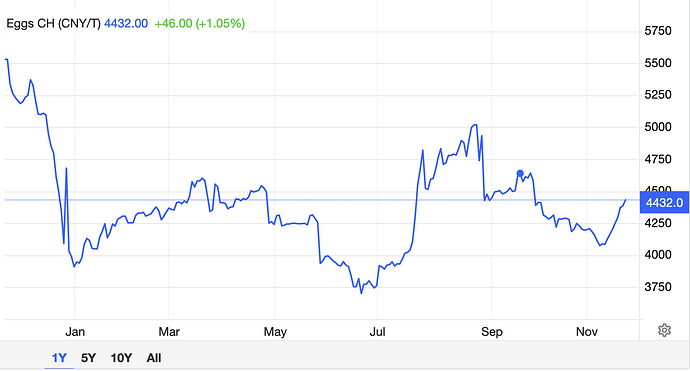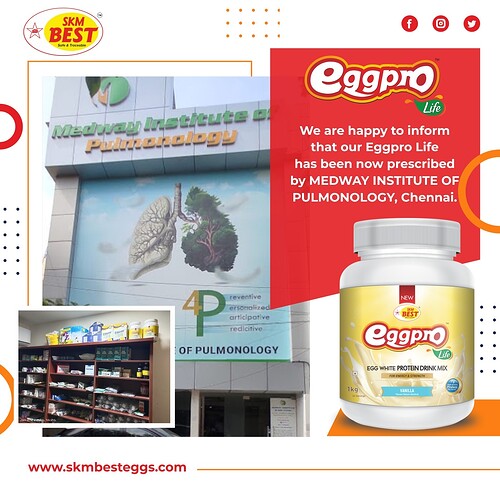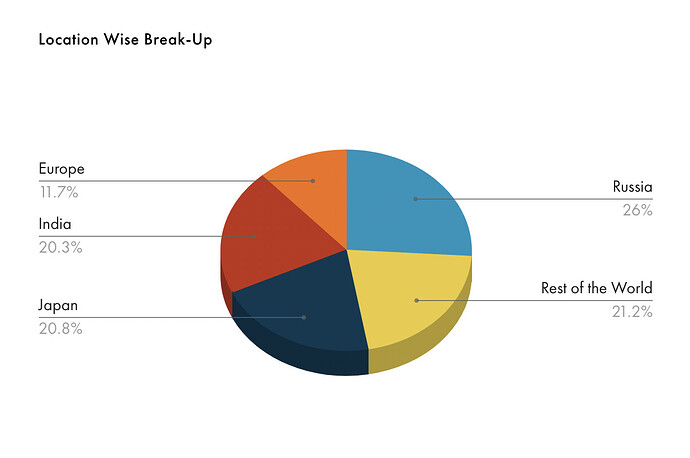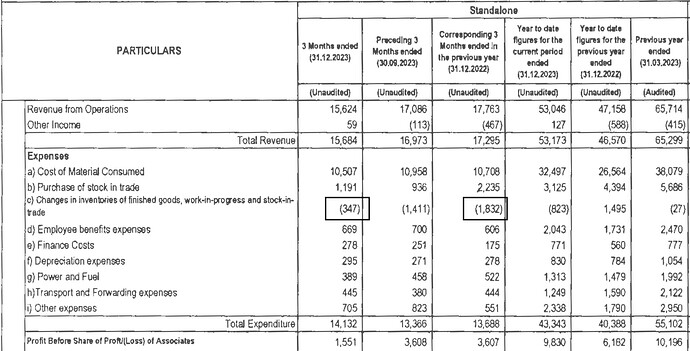Although stock has reasonable valuation, it’s trending downwards and there is a need for a clear trigger so that downtrend is arrested.
This is a commodity company, apart from geo expansion what are the other avenues of growth?
Disc: Invested.
After Re-appearance of Bird Flu in US Egg prices have doubled in 2 weeks.
Eggs US - Price - Chart - Historical Data - News.
Late to the yolk party?
I only recently screened this stock via a modified “Magic Formula” screen. Magic formula is used to screen stocks with high earnings yield (PE reversed) and high return on capital. This post is my quick study of the company at the current valuation. Please feel free to comment and share your opinions.
Eggs market (Asia):
- The market is expected to grow annually by 9.17% (CAGR 2023-2028)
- Biggest consumer is China (Around 37%)
- Consistent consumption growth (not exponential) expected. Below graph shows revenue growth from Egg market in Asia:
Is this a pure commodity play? Understanding cyclicality
You’re absolutely right as eggs are nothing but a commodity. But an important characteristic of a commodity company is cyclicality. Speaking specifically about the egg market, demand side cyclicality is very minimal. Examples of demand side cyclical sectors would be hotels, tourism etc. Sure there could be some shallow cyclicality around the holidays when baking volume and egg consumption increases, but the majority of the fluctuation in price revolves around supply side cyclicality:
- Mortality rate: Mortality rate may rise due to high temperature. The average mortality rate of a flock is from 20 to 25 percent per year. Hence the summer months have higher hen mortality rates due to heat stress, respiratory diseases, insect diseases and change in water intake and appetite. In order to combat many of these factors, poultry farmers may reduce ventilation to maintain a comfortable temperature for the birds. However, this can lead to poor air quality and an increased risk of respiratory problems. What’s the biggest concern is that Egg-laying hens are more productive during warmer months. Hence, one bad summer could affect the business rather drastically.
- Production costs: Fluctuations in the cost of feed ingredients, such as grains and protein sources, can affect egg prices. If feed prices rise, the company may need to pass on those higher costs to consumers in the form of higher egg prices.
- Extreme conditions: Extreme weather conditions, such as droughts or floods, can affect feed availability and transportation of eggs, potentially leading to supply shortages and higher prices. Along with this don’t forget possible outbreaks of H5N1, a highly transmissible and fatal strain of avian influenza, or bird flu.
Those tracking this company might have already realised that, apart from a black swan sort of an event (such as point 3), SKM is backward integrated. They have a Rs 10 Cr feed mill for producing poultry feed. Laboratories attached to the mill to ensure nutrient composition and feed free of toxins, pesticides etc. Allows for specific formulations for different types of chicks. Why is this important? This removes a lot of the cyclicality aspect in production costs. When it comes to mortality rate, they have high end infrastructure to minimise external effects to the production cycle. What about unpredictable bird flu outbreaks? Looks like the company has this taken care of as well. The company’s website mentions:
Avian Influenza - Strict biosecurity measures are deployed to avoid the Avian Influenza outbreak. Fencing, No vegetation in the farm, sanitation of vehicles are part of biosecurity measures.
What this ultimately means is that SKM is able to reduce a lot of cyclical aspects in a cyclical commodity such as eggs. That’s a huge advantage that often goes unnoticed.
Egg prices (Asia):
Recently, @ankit_tripathi brought up a very important point in this thread regarding egg price trends in the US. However, SKM’s primary client base being Asia and Europe, egg prices in China should be a better descriptor of the trend. It has gone up by around 10%. However it looks like the egg prices are trending upwards. This can be interpreted in a positive way if the company is able to prevent a supply side shock due to a bird flu outbreak and maintain a stable production rate, they should benefit from higher egg prices even if they maintain their current volumes.
Financial performancee:
- Profit/Sales growth: Probably the most important point in this post. The scepticism of the jump in profit growth! Operating profit in Mar’22 stood at 31Cr and in Mar’23 jumped to a whopping 144Cr. There’s no way that’s normal right? Well the primary reason for this is the sales growth and margin expansion causing a combined exponential jump. This is a classic case of Operating leverage! Sales during the same period doubled while the OPM also doubled during this time causing a whopping 4X on the profit during this year. The real question you’re supposed to be asking is what is a normal profit growth rate going forward and that will depend on whether your margins are sustainable or not! More in the Valuation section.
- Margins: They are currently at peak margins of 24%. Normally, peak margins would be a red flag in a commodity company. Especially when the management has not provided any PPTs/Concalls recently to clarify the guidance. However, as I said earlier about cyclicality, the company seems to have infrastructure capable of eliminating much of that cyclicality. These margins of 20-25% are looking stable for the past 4 quarters. Hence, these margins could end up being sustainable in the long run, but only time will tell (if not the management).
- Piotroski score: A piotroski score of 8/9 indicates a very strong financial performance all round.
- Cash flow: Sitting on healthy Cash flow from operations of 60Cr
- Debt situation: Now if you haven’t noticed already, debt on the company’s balance sheet is something to consider. They have Rs 141 Cr of borrowings. Debt is not necessarily a bad thing. Especially if the company is able to make good use of the debt. What do we check for that? ROCE - 46% and ROIC - 31% shows that the company is generating good return on the capital at hand. Besides, the company has reserves of Rs 225Cr showing that they are have undertaken a manageable amount of debt. The CARE rating also suggests that the outlook is stable and has improved significantly from last year (D/E of 0.8 to 0.5) however any more debt would start to slip out of hand:
Any further large debt-funded capex leading to deterioration in the capital structure with overall gearing above the range of 0.75x.
- Capex: the company had planned for capex towards setting up of Environmental controlled (EC) shed for birds and Bio -gas plant with total project cost of ₹70 crore of which ₹50 crore funded by debt and rest by accruals. The project is expected to be completed by Q1FY25. The debt looks to be primarily used to fund this Capex.
Valuation:
- PE ratio: Trading at a PE of 8.7, the PE ratio has decreased from levels of 27 in 2022. The primary reason for the decrease looks to be the exponential increase in earnings. These growth rates are probably not sustainable due to which the PE does not entirely reflect the recent earnings. So is it undervalued? The PEG is a great measure for this!
- PEG ratio: A PEG of 0.07!? Surely that’s a steal! Well, this only points to the fact that the growth is absolutely unsustainable. So what is a sustainable number that we can expect? The honest answer is that no-one can tell considering the company’s lumpy numbers in the past. But what we can do is be prepared for a few different scenarios. If we were to expect a modest 10% EBITDA growth rate, that would give us a PEG of 0.9 for the current PE, which is in my opinion fairly valued. And any growth rate above 10% would start making the current PE more and more undervalued. In my opinion, the Capex initiative to be completed in Q1 FY’25 will only help the company expand its margins. So they are on the right track to sustainable profitability. I would assume a 15% growth rate is not out of the question.
Anything to watch out for?
- Operating deleverage: Currently operating leverage looks to have kicked in. What does this mean? It’s a period when your fixed costs remain constant but your revenue increases, leading to margin expansion and improved asset turns. This leads to explosive growth rates, as seen for SKM over the last year. Asset turnover improved from 1.3 in FY’21 to 2.3 in FY’23. But the exact opposite would lead to a situation of operating deleverage. Where companies lose demand, but their fixed costs remain the same and their margins slump ultimately leading to asset turns dropping again. What goes up exponentially could come down exponentially!
- Lack of info: No matter how much you dig and dig, unless you have someone from the inside of the business telling you what’s happening, everything that we discuss is just speculation. I hate it when companies do the bare minimum when it comes to concalls/PPTs/interviews, SKM is another such company where you are not going to get any upfront guidance. It makes our jobs as retail investors much harder.
So are you too late to the yolk party? What do you guys think? ![]()
Open to everyone’s opinion
Very nicely covered ![]() … your eggspert opinion spot on
… your eggspert opinion spot on ![]()
The bird flu season in Japan typically begins in October each year.
Since mid-October, three HPAI outbreaks have occurred across Bulgaria.
Among SKM, Ovobel and Venkys which seems a better investment bet at this time?
Ovobel has had a change in management.
Results - Q3 FY’24
Summary:
Revenue - Rs 153 Cr
Net profit - Rs 12 Cr
OPM - 13%
Overall, the results are disappointing to most. The stock has already corrected 20% after the results came out. But this post will try and dig a bit deeper. With the limited knowledge we have about the breakdown, let’s try and look between the lines.
Let’s start with the geographical split:
Russia is their biggest importer. Followed by Japan and the domestic market in India.
What’s happening in Russia?
The egg prices are sky high. Egg farmers claim that the industry is in “a perfect storm” with prices soaring to over 40% this year.
Russian egg imports will be exempt from the import duty for the first 6 months of 2024, the economy development ministry has decided. Authorities expect that imports from ‘friendly’ countries could help return the balance to the market. The price hike has happened due to a perfect storm in the Russian egg industry, Leonid Kkolod, an independent agricultural analyst, told the local press. Over the past 2 years, Russian egg farms have been silently suffering having to maintain operations with ‘negative profitability’. Among the reasons that pushed the profitability into the red zone, tough import dependence is the first to blame.
Source: poultryworld
Is the situation going to change? Yes! It looks like the the demand for eggs in Russia will primarily be met by India. Similarly, Japan’s primary egg exporter is also India, and their economy is also recovering with their stock market hitting a 34-year high. This is all positive news for Indian exporters.
Domestic demand for egg powder:
The Indian Egg powder market is forecasted to grow at a 7.1% CAGR through to 2029. Again, egg prices have risen sharply in India. I’m from Bangalore and an egg cost me Rs 6.5 from my local grocery shop. A sharp rise in egg prices is seen in the country due to the decline in production. Good export demand is aiding the uptrend in price, which producers said is likely to hold on to current levels till February.
So what is SKM doing with all this demand?
Stocking up inventory! The advantage about egg powder, unlike eggs, is its longer shelf life. SKM’s recent results clearly points to the fact that the drop in OPM% margins is primarily due to stocking up of inventory:
The expense related to changes in inventories of finished goods increased from -18.3Cr from last year to -3.47Cr this year. This suggests that the company is investing more in its inventory of finished goods during the current quarter compared to the same period last year. Meaning the value of the inventory is going up. Again, I’m not a financial expert and would like it if someone can analyze it further for me. So that explains the drop in OPM% and net profits.
Before I end the post, I also feel the recent Tamil Nadu floods have affected the business in some respect. Although, there has not been any explicit comment about the same by the management, there are several news articles describing the floods and Erode, Tamil Nadu is one of the cities that experienced heavy rainfall. The situation is much better now with rains especially in the in-land districts.
Please do share your thoughts ![]()
I happened to read somewhere that the prices of Maize have corrected to almost half from the peak during the year of 2022.
Similarly, there is a decline of Soya prices by about 30% from its peak.
Although the prices for both these primary raw material are not at the rock bottom but relative to recent past 12-18 months, raw material inflation appears to have soften.
Shared link is of “2014”
Please be careful while sharing data it might impact some.
Oops. Thanks for pointing out. I read the date at the top left right above the article but turns out that’s today’s date. Removing the link
The famous investor Li Lu, who considers himself a disciple of Charlie Munger, has a wonderful lecture about stock-picking. It’s on YouTube.
His investing technique is picking totally out of favour, down on their knees companies. Vijay Kedia also is also a remarkably successful exponent of this strategy.
Of course, the trick would be to identify companies which show the yearning to recover.
SKM Egg is down some 30+% from its recent price. Continuous lower circuit.
The company has in the past seen dizzying rises and equally steep falls. There are some interesting opinions here in this thread, which indicate that the decline in its financials must be temporary.
Time to take a plunge?
Disclaimer: I have dipped my toes a bit today.
I hope the inventory is for seizing the opportunity. To be devil’s advocate, could it be because it has not found buyers?
Companies don’t sit on unsold stock when they can get quick profits. After all, if they sell the powder now, they may increase the production?
Disclaimer: Bought some today, tempted by the low price.
Very well analysed but you are bang on point when you concluded the post. I was almost seeing daily UC and thought I missed the bus but always questioned that if the growth is sustainable? And to be pleased, I didn’t enter when the stock was roaring. I was just trying to answer one question and it deterred me to not invest -
Why did the sales double March 23 and can it sustain? As Russia related reports were out, it further questioned my ability to project steady sales as I am.not clear if the sudden demand of Indian eggs will continue once the war in Russia gets stable. The existing supply chain will kick in and This company may have to sit on the fence.
Global events can turn the dial for a company but unless management clarifies of the demand is sustainable, it’s a big IF. I disagree to your notion of operating leverage kickin in. Why? Bcos the sales have double and margin gain is secondary. Had the sales remained same and it had made 144 cr profit, then I would give credit to operating leverage.
The market knew something which we didn’t and that’s what happened. The sales are slumping down and there’s a good probability that the events which caused the supply to be from India is no more . Existing Russia supply chain disruptions have stabilised.
So , I am sitting on the fence as I don’t know if sales will further drop. Unless management clarifies their stand on what made the sales double and is it sustainable, we are just playing blind cards game.
Promoter share acquisition
It’s just inter se transfer. Not additional buying from the market.
Hi.
I used to track SKM back in 2014-17 period, when it went from sub 20s to 250s.Was a beginner that time and made the mistake of entering at the wrong time.I appreciate the management for building such a business. And I see they have cracked markets, which were not easy to crack.But I exited after I found the management has same family business which may not be in the interest of minority shareholders.
Maize prices
The poultry industry anticipates that 10-20 percent of maize could be used for ethanol production, which would increase the demand-supply gap further, causing a spike in maize prices.
Since the government has fixed a cap of 1.7 million tonnes of sugar for ethanol production anticipating a lower sugarcane output, it is hoping to largely fill the gap by allowing more quantities of maize to be used for producing ethanol, in order to achieve its target of 15 percent ethanol blending with petrol this year.
Neeraj Kumar Srivastava, former Chairman of the Compound Livestock Feed Manufacturers Association (CLFMA):
Already it is a hand-to-mouth situation in the case of maize. Further fall in supply could take maize prices from the current level of Rs 25 per kg to Rs 30 per kg, unless more is imported
What does this mean for SKM?
Maize is the primary feed ingredient for SKM. Quoting their website:
The birds are fed a highly nutritious, balanced diet composed primarily of maize, grains with vitamins and minerals added.
But unlike several smaller poultry players, SKM is also backward integrated and they have their own feed mill established for manufacturing poultry feed. Hence, while poultry feed price has increased from Rs 35 to 42 per kg, SKM probably has not felt as big of a pinch as of yet due to a rise in exports and the fact that they make their feed in house. Companies like Ovobel are probably facing a lot more pressure on their margins due to the increase in maize prices, with their OPM% dropping to below 0% and reporting a loss making quarter:
Compare that to SKM’s costs, the increase is not as drastic, and that is the advantage of backward integration:
There may be a little more pressure on margins in the coming quarters if the maize prices do end up rising further, but in my opinion the company is better placed to survive over its competitors. Thoughts?








